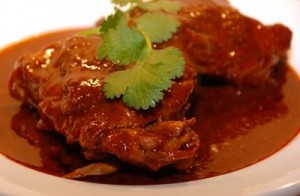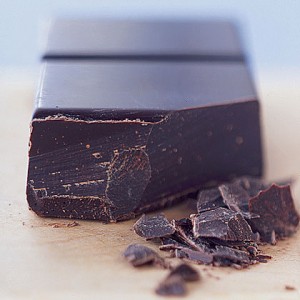By Marsha Fottler –
 Most eaters and cooks in the United States are used to seeing chocolate on the dessert side of the menu. That’s changing. Chocolate as an ingredient is crossing over to the appetizer and entree categories and it’s happening fast. Restaurant chefs and home cooks all over the country are experimenting with the culinary possibilities of chocolate as a delicious way to add complexity and richness to the flavor profile of many existing recipes as well as to concoctions that are brand new. Part of the reason is the popularity of Mexican cuisine. Mexican chefs and home cooks have been using chocolate in savory dishes for centuries. Mexico has a long and complex history with chocolate.
Most eaters and cooks in the United States are used to seeing chocolate on the dessert side of the menu. That’s changing. Chocolate as an ingredient is crossing over to the appetizer and entree categories and it’s happening fast. Restaurant chefs and home cooks all over the country are experimenting with the culinary possibilities of chocolate as a delicious way to add complexity and richness to the flavor profile of many existing recipes as well as to concoctions that are brand new. Part of the reason is the popularity of Mexican cuisine. Mexican chefs and home cooks have been using chocolate in savory dishes for centuries. Mexico has a long and complex history with chocolate.
Another reason for the great chocolate crossover is the current popularity of dark and extra-dark chocolate. It’s become chic to eat it. And it has health benefits. Chefs prefer bittersweet chocolate, not milk chocolate and certainly not white chocolate which isn’t even chocolate at all but a by-product of chocolate processing. Dark chocolate isn’t even sweet. Dark chocolate that has a 70 percent cocoa content has a real kick to it. It’s dense and toothsome, but it’s not sugar you’re tasting. Some of the chef-preferred brands include La Soledad Oaxacan (use in your Mexican chicken mole), Dagoba, Sharffen Berger, Ghiradelli, Lindt and Valhroma. Gourmet markets carry them or order online in either powder or chunk forms.
 Chefs who are experimenting with dark chocolate for savory dishes consider chocolate another spice and especially like to pair it with the peppery spices. For example, Chef Jehangir Mehta, owner of Metaphor in Manhattan, has come up with a seared Korean chili duck with a chocolate Malbec sauce. He also does chocolate espresso lamb-pop chops that have his customers coming back for more. Famed Mexican-fusion chef and cookbook author Rick Bayless (Frontera Grill in Chicago) has been perfecting his Mexican chicken mole for 13 years. He served it recently at the White House for a state dinner. The recipe calls for ½ cup of finely chopped Mexican chocolate. And Philadelphia chef Jose Garces of Chifa (a Peruvian-Cantonese restaurant) says his favorite way to use dark chocolate is to pair it with duck because the earthy chocolate works in concert with smoky, gamey meats to produce sublime and intense flavors.
Chefs who are experimenting with dark chocolate for savory dishes consider chocolate another spice and especially like to pair it with the peppery spices. For example, Chef Jehangir Mehta, owner of Metaphor in Manhattan, has come up with a seared Korean chili duck with a chocolate Malbec sauce. He also does chocolate espresso lamb-pop chops that have his customers coming back for more. Famed Mexican-fusion chef and cookbook author Rick Bayless (Frontera Grill in Chicago) has been perfecting his Mexican chicken mole for 13 years. He served it recently at the White House for a state dinner. The recipe calls for ½ cup of finely chopped Mexican chocolate. And Philadelphia chef Jose Garces of Chifa (a Peruvian-Cantonese restaurant) says his favorite way to use dark chocolate is to pair it with duck because the earthy chocolate works in concert with smoky, gamey meats to produce sublime and intense flavors.
But there’s plenty of room in seafood dishes for chocolate too. At the Signature Room in Chicago, Chef Patrick Sheerin has had great success pairing citrus-cured scallops with cocoa nib gremolata and oranges. He says any time you pair chocolate with citrus you’ve got a winner but putting both with silky scallops sends the recipe over the top. The chef also does a warm beet salad with cocoa caraway bread pudding that’s a hit with his customers.
If restaurant chefs can do it so can you. Move your dark chocolate over to your spice rack and start having some culinary fun. Here are two recipes to get your started.
Braised Short Ribs with Chocolate and Rosemary
6 pounds bone-in ribs
1 1/2 cups finely chopped onions
1/4 cup finely chopped shallots
1/4 cup finely chopped celery
1/4 cup finely chopped peeled carrots
3 garlic cloves, minced
1/4 cup diced pancetta
2 cups dry red wine
3 cups low-salt chicken broth
2 cups chopped drained canned diced tomatoes
2 tablespoons chopped fresh parsley
1 large fresh thyme sprig
1 bay leaf
3 tablespoons shaved or grated bittersweet chocolate
2 tablespoons unsweetened Dutch-processed cocoa powder
1 teaspoon finely chopped fresh rosemary
 Heat heavy large pot over medium heat. Add pancetta and sauté until crisp. Using slotted spoon, transfer pancetta to paper towels to drain. Sprinkle ribs with salt and pepper. Working in batches, brown ribs in drippings in pot over medium-high heat until brown on all sides, about 8 minutes per batch. Transfer to plate. Add onions and next 4 ingredients to pot. Cover, reduce heat to medium, and cook until vegetables are soft, stirring occasionally, about 10 minutes. Add wine. Boil uncovered until liquid is reduced by half, scraping up browned bits, about 5 minutes. Add broth, tomatoes, parsley, thyme, bay leaf, and pancetta. Return ribs to pot, cover partially, and
Heat heavy large pot over medium heat. Add pancetta and sauté until crisp. Using slotted spoon, transfer pancetta to paper towels to drain. Sprinkle ribs with salt and pepper. Working in batches, brown ribs in drippings in pot over medium-high heat until brown on all sides, about 8 minutes per batch. Transfer to plate. Add onions and next 4 ingredients to pot. Cover, reduce heat to medium, and cook until vegetables are soft, stirring occasionally, about 10 minutes. Add wine. Boil uncovered until liquid is reduced by half, scraping up browned bits, about 5 minutes. Add broth, tomatoes, parsley, thyme, bay leaf, and pancetta. Return ribs to pot, cover partially, and
simmer 1 1/2 hours. Uncover and simmer until rib meat is tender, stirring occasionally, about 1 1/2 hours longer.
Transfer ribs to plate; discard bay leaf. Spoon fat from surface of sauce. Boil sauce until beginning to thicken, about 8 minutes. Reduce heat to medium. Add chocolate, cocoa powder, and rosemary; stir until chocolate melts. Season to taste with salt and pepper. Return ribs to pot. Simmer, about 5 minutes.
Spiced Coco Dry Rub on Lamb Kabobs
This cocoa spice rub works especially well with lamb. Although the smell of this rub is quite chocolate-y, the flavor on the grilled meat is very subtle. Use the rub on cubed lamb shoulder and leg for kabobs. Chocolate is the perfect spice for the richness of lamb.
1 cup cocoa powder (unsweetened)
1/4 cup Kosher salt
2 teaspoons dried red pepper flakes, chopped fine
1/2 teaspoon ground cloves
2 tablespoons granulated sugar
4 pounds lamb shoulder and/or leg, cut into 1-1/2 inch cubes
2 red onions
Combine all ingredients in the bowl of a food processor, spice grinder, or mortar and pestle. Grind until the pepper flakes are crushed into a fine powder. Store leftovers in a tightly covered jar for up to one month. Generously coat the lamb cubes with the dry rub. Using metal skewers, alter the lamb cubes with pieces of red onion. Let the lamb marinate for up to 12 hours or overnight in the refrigerator. Light the grill. Remove the lamb from the refrigerator and bring to room temperature before grilling. Grill over direct coals, turning once after 5 minutes. If grill has a lid, cover the meat while it is grilling. Using an instant read thermometer, check the internal temperature of the lamb cubes and remove when the temperature reaches 125 degrees for medium-rare meat.

Very nice article! Thanks for sharing it with us!
Really great post, I’ll definitelly come back on your website.